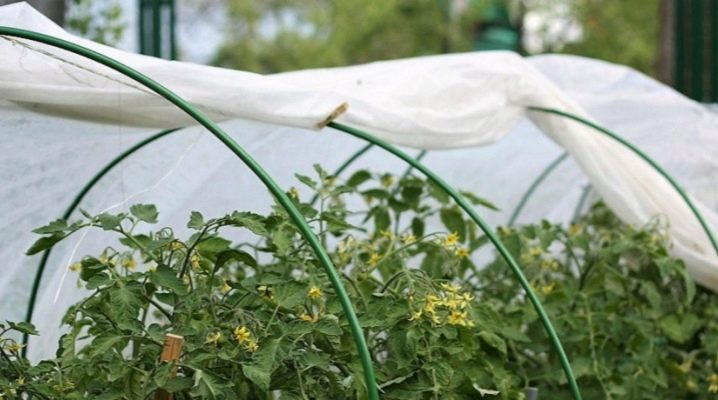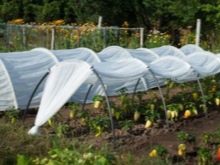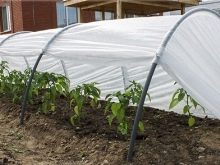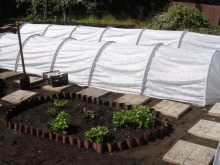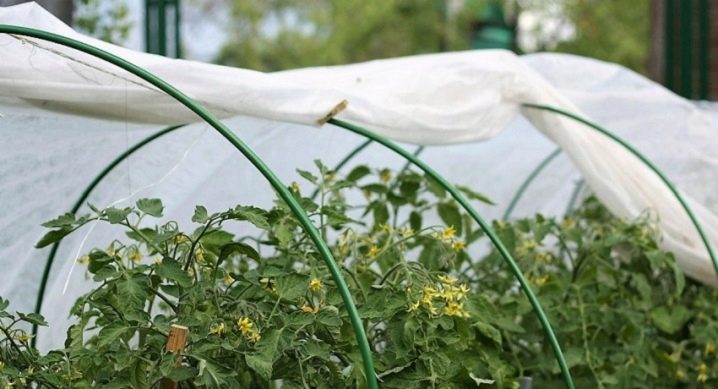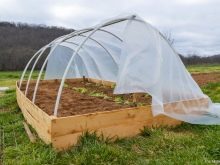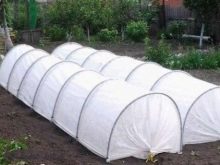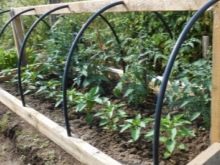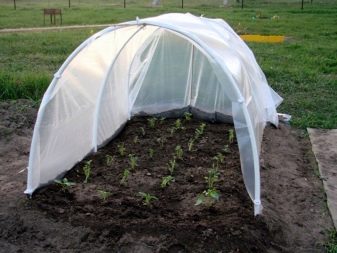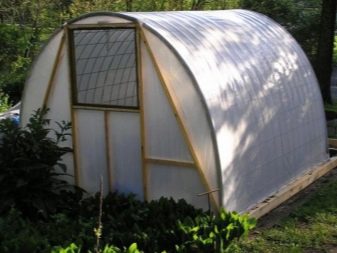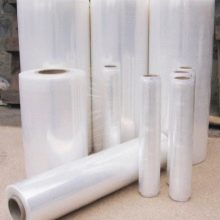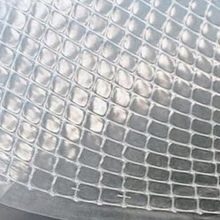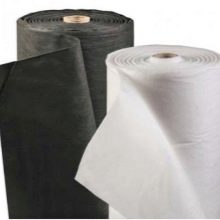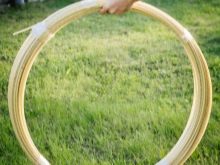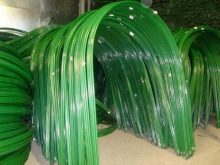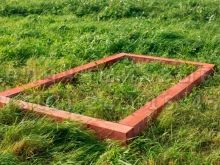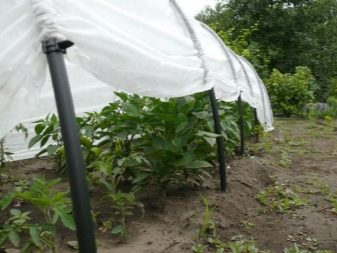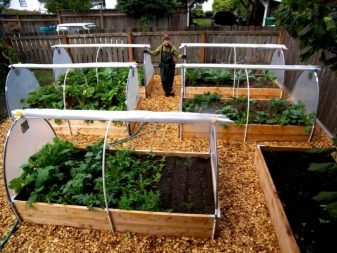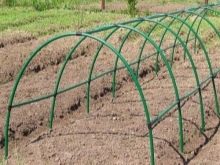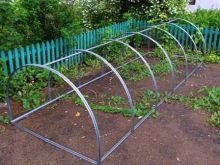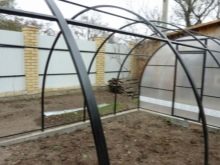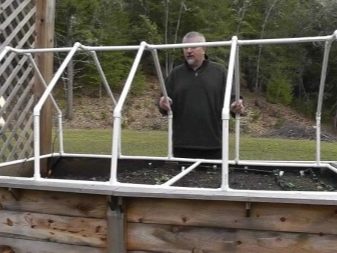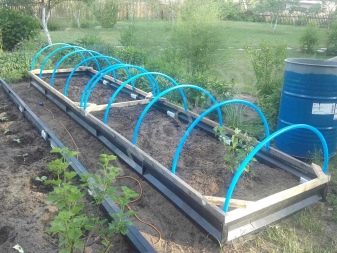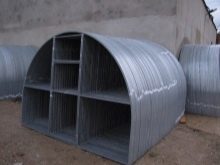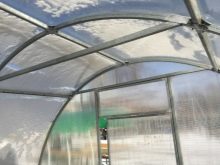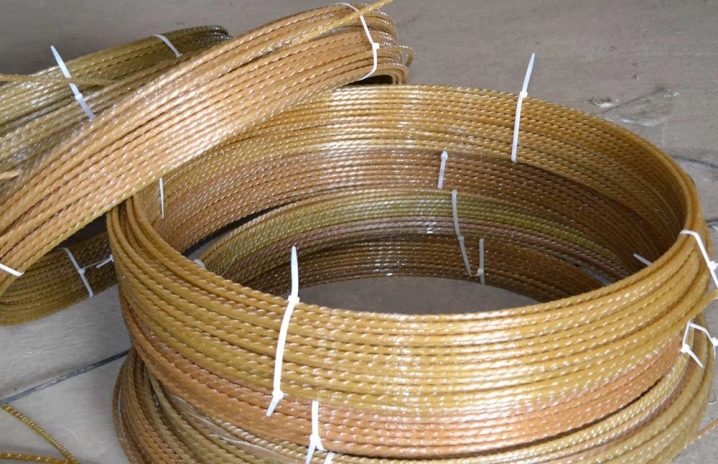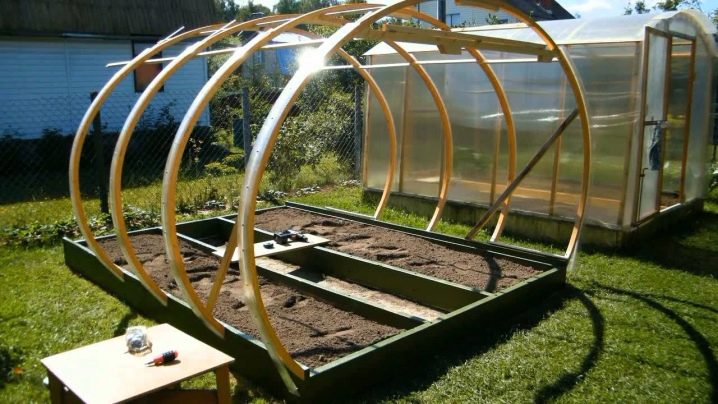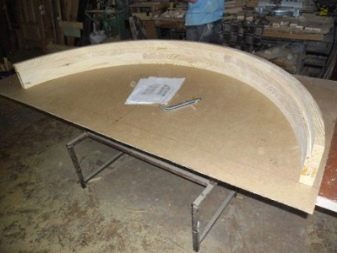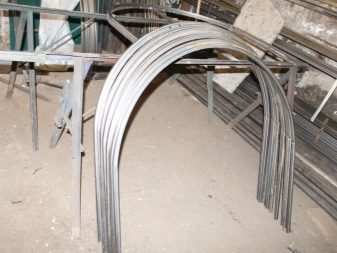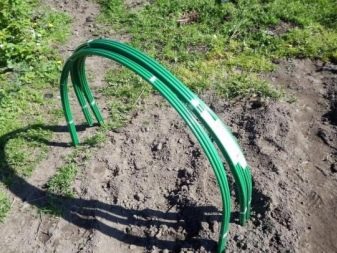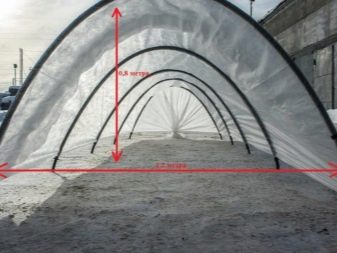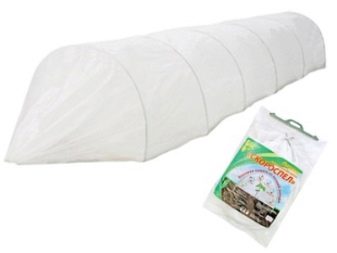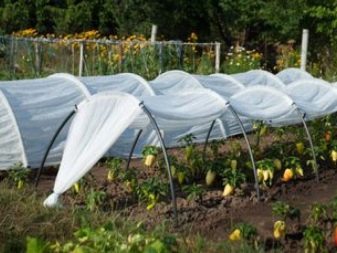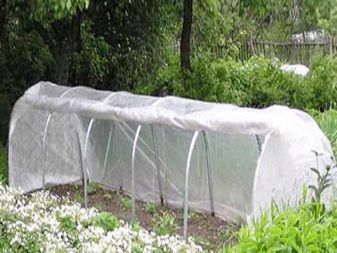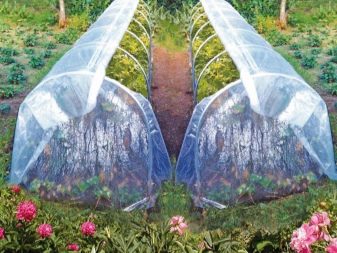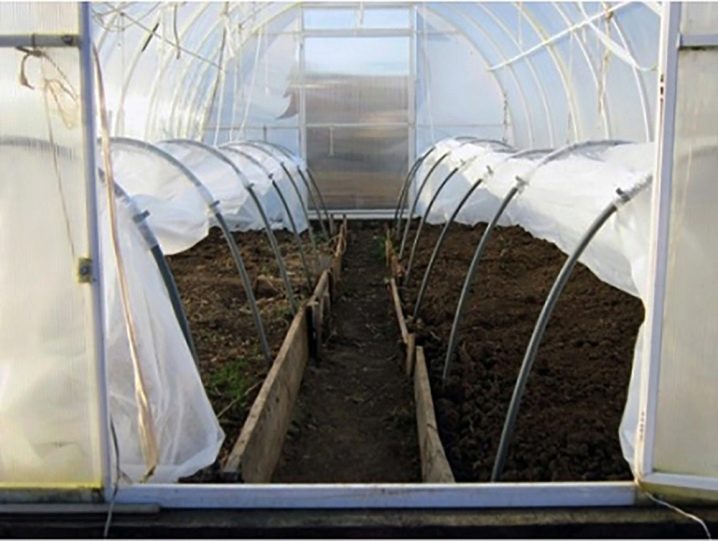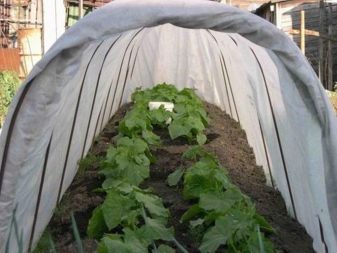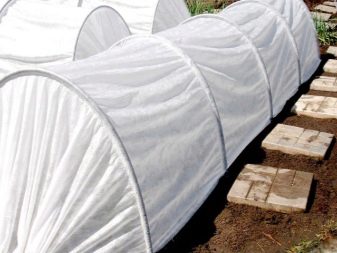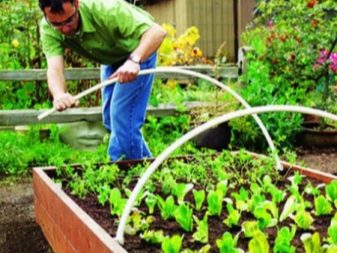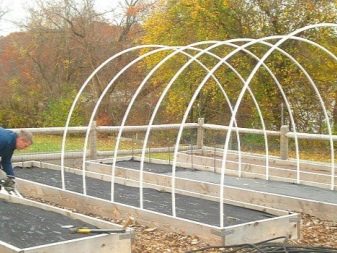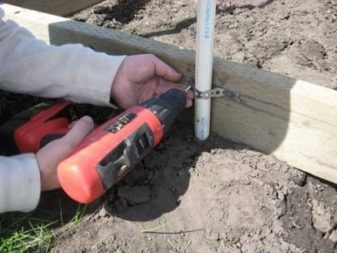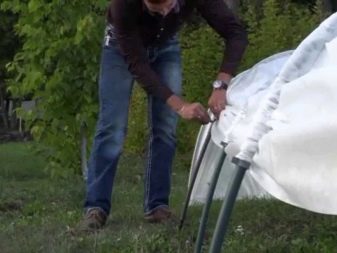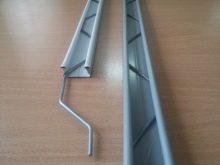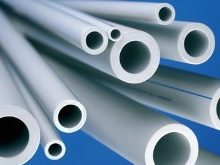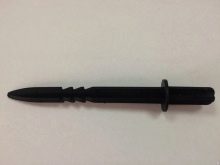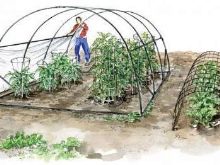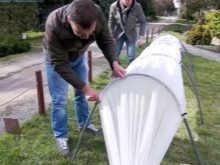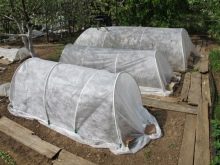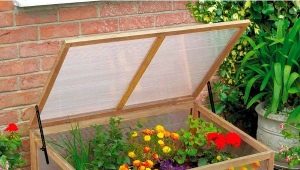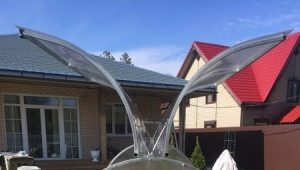Greenhouses from arcs with covering materials: description and use
Weather conditions do not always allow to grow and early to get a crop of vegetables, herbs, berries. Greenhouses help avoid the adverse effects of adverse weather conditions and successfully grow crops.
What are we for?
It is not always possible to build a large solid greenhouse. However, there is another option - to build a greenhouse of the arcs. These greenhouses - the frame of the arches, covered with any covering material. Greenhouses are not limited to using them only for seedlings, but they successfully grow vegetables.
Their purpose is different, below we consider in what qualities they are used.
- As a place of growing vegetables from early spring to late autumn. The design should have sufficient height and strength, well-fixed covering material, access to planted vegetables. The greenhouse is removed with the onset of heat, when the seedlings take root.
- For transplanting into the soil and hardening plants. Its purpose is to temporarily cover cucumbers, tomatoes, peppers who are afraid of the cold. Covering film protects seedlings not only from the cold, but also from the scorching heat.
- The greenhouse grows seedlings of winter-hardy crops and flowers, and in early spring greens and radishes are cultivated in it.
- It is used for short-term protection of plants with a long period of germination: carrots, beets, parsley. Seed germination time is reduced by two to three times. Then the greenhouse is removed.
- During the occurrence of harmful insects, a greenhouse will protect against their mass invasion, and its installation is short-lived.
- This structure also protects against birds, since the film does not give access to the beds, even if they are not completely covered.
Special features
The peculiarity of the arched design is the lack of the need to establish the foundation during its construction. It can be built in any size, at will, and based on the area of the summer cottage, and it is very easy to maintain. In addition, this greenhouse is easy to build yourself.
When constructing an arcuate greenhouse, it is necessary to take into account that high structures are exposed to winds and do not have sufficient stability.
Another distinctive feature is its low weight, which makes it easy to carry it to any place on the site. The design does not need to be further aired, and the soil remains wet for several days after watering. The process of installation of the arc-shaped greenhouse itself is simple, it will not take much time, since it is equipped with pegs to which the arcs are attached.
Production supplies the sale of ready-made sets of arches, which are a frame with arches, resembling an accordion, stitched in a covering sheet. Instead of production kits, you can independently choose the frame arc in any quantity to build a greenhouse of the desired size.
For covering material used:
- plastic film of different thickness;
- reinforced or reinforced polyethylene;
- agrofibre (nonwoven fabric).
The ability to pass the sun's rays, not to let in the cold and wind, to have good strength for long-term use - these are the main qualities required for a covering sheet. Alternating polyethylene with a non-woven fabric - a guarantee of good plant growth.Polyethylene is used at an early stage of plant development in the spring to create favorable conditions and protection from cold weather.
Non-woven shelter is necessary in the summer to protect the crop from the hot sun and to provide sufficient aeration.
Greenhouse arcs have a different shape: a circle, an oval, and even a rectangle.
Species
Industrial film greenhouses may be ready for installation. A set of such a greenhouse assembly includes arcs, slats, pegs, clips, fixing the covering sheet on the arches. The kit is often supplemented with a covering material. Ready sets, having a certain length, require beds of the same size, and there is often no possibility to change the arched gap. This is a simple replacement for the film winter greenhouses.
A variety of industrial greenhouses is represented by a set with folding arches of a stable size sewn into the canvas. The simplest option is a series of fortified arches covered with foil. The designs of the arched greenhouses have a different shape of arches, ways of their disclosure, as well as the type of frame. Covering cloth can be turned to the side.There is a variant of the greenhouse - “breadbasket”, in which the film is lifted using a special cover using a control device.
Materials
Make greenhouse arcs of various materials: metal, plastic, wood.
Metal arc
For their manufacture apply:
- wire section from 4 mm;
- metal strips with a thickness of 2-6 mm;
- corners, profile aluminum and steel pipes.
The arcs are made of flexible wire, 10-12 mm of steel tubes, and outside they are coated with a layer of polyvinyl chloride. Metal arc is distinguished by strength, the ability to transfer loads, long-term operation. They are easily installed in the soil, can not be deformed. The metal base is protected by PVC layer serving as a cover, and protects against adverse conditions.
Reinforcement of metal makes it possible to build a structure of large dimensions and different shapes. The downside is the price of metal arcs, the complexity of design, a large investment of time and effort.
Plastic arcs
Plastic arches, compared to metal, have greater flexibility, which allows you to build a greenhouse frame of any shape and size.They are easy to install and remove, because their design is simple and weighs a little. Differ in long service life, are less subject to wear, are made of ecological material - PVC. The quality of plastic arcs affects the size of the cross section of pipes, it ranges from 20 to 25 mm.
The disadvantage of such arcs is the difficulty of fixing them in the soil, requiring the use of pegs or profile residues. Another disadvantage is the instability, the wind is able to bring down the greenhouse and damage plantings.
Galvanized profile arches
Such arcs have almost no flaws, their service life is very long. Especially recommended for regions with strong winds, such a greenhouse is hard to pull away.
Arches from fiberglass material
These arcs are much lighter than metal-plastic ones. Fiberglass bends easily, resistant to corrosion. But, having a small weight, they easily overturn under gusts of wind.
Polypropylene arcs
These arcs are solid, with thick walls. To bend them requires some effort. Usually they are used in greenhouses of small dimensions.
Arcs of wood
Wood is also a material for building a greenhouse frame.
For this purpose are used:
- alder or willow branches with good flexibility;
- planks and bars, as well as other lumber, and the shape of the greenhouse will be rectangular.
The wooden frame has sufficient strength, but the tree is short-lived, it can rot or be destroyed by insects or rodents.
When building an arched greenhouse on its own, material can serve as the remains of water pipes, various profiles, and even an old waste irrigation hose, from which excellent arcs are obtained.
Dimensions
Greenhouses from industrial arcs can have such dimensions: height from 50 cm to 1 m 30 cm, width from 60 cm to 1 m 20 cm. Its length determines the number of arcs and the gap between them. Most often, the length of industrial greenhouses is 4 m, 6 m and 8 m. Greenhouses with a length of 4 m and a width of one and a half meters and an interval between arcs of about 50 cm are convenient in operation.
The arcs, sold in a set of 6 pieces, usually have a length of 2 m and 3 m in unfolded form. When installing them with an interval of 80 cm - 1 m, the length of the greenhouse will be about 5 meters. When using arcs of 2 m in length, the height of the greenhouse will be within 70 cm, while with arcs 3 meters in length it will be taller, about 90 cm.
For a finished industrial greenhouse, it is not necessary to make complex drawings with the exact dimensions necessary for the construction of the structure.
For such a greenhouse, you should only calculate the length, width and height, as well as determine the number of arcs. When calculating the width of the greenhouse, you need to consider that it should be wider than the bed by about 30 cm.
The height of the greenhouse is measured from the soil to the upper limit of the arc and ranges from one and a half meters to a meter. The length and height of the arc directly affect its width, and the gap between the arches and their number determines the length.
Popular models
Industry supplies for sale ready-made sets of greenhouses of various sizes, designed for a bed of a certain length. Industrial greenhouses are represented by the following models.
Has ripened
It has several modifications with different dimensions of arcs: with a width of 100 and 110 cm, a height of 120 and 160 cm and a length of 300 and 500 cm.
In the complete set of prefabricated greenhouse, in addition to steel wire arcs (4 and 6 pieces in the set), covered with polyvinyl chloride, there are:
- crossbars - 1 and 3 pcs .;
- clamping fasteners;
- rings with pegs for fixing in the soil.
Building a greenhouse is quite simple. The arcs are connected by crossbeams, placed on a bed, covering material is fixed with pegs and clamps.
"Hastily" can be moved around the site, as it has a low weight.
Cucumber
The galvanized profile serves as material for the arcs, which have the following dimensions - width and height of one meter, length - 5 m. The material of the arcs provides greater strength, durability, the greenhouse is easily installed. Covering material is a nonwoven fabric or polyethylene.
The kit includes:
- arc - 7 pieces;
- arc extenders - 14 pieces;
- 1 crossbar;
- fasteners for the film - 6 pieces;
- clips - 22 pieces;
- slats - 2 pieces;
- fasteners for the film - 8 pieces;
- thread from nylon for fixing the ends.
Greenhouses are used for growing seedlings, cucumbers, low tomatoes, peppers.
Hawk
Made of HDPE pipes, whose length is 600 cm, width 120 cm. Can be used both in open ground and in the greenhouse.
The kit consists of:
- arc section of 20 mm in the amount of 7 pieces;
- 15 pegs for fixing in the ground;
- non-woven cloth 3 per 10 m;
- fixing clamps for web - 15 pieces.
The arcs are installed on the bed, the distance between them is 80 cm, then the nonwoven fabric is tensioned, which is fixed with clips on the arcs as needed.Bottom around the perimeter of the canvas is fixed with stones or boards.
The absence of the crossbar in the set affects the stability of the greenhouse, which requires additional strengthening of the arcs.
Agronomist and Dayaks
The design of these greenhouses is similar. Flexible pipes of arches with a section of 20 mm are made of plastic of big durability. Greenhouse dimensions: height 800 mm, width 110 mm and 120 mm, length 4 m, 6 m and 8 m. Dense covering material has the ability to protect against ultraviolet rays. These models of greenhouses are highly resistant, since the arcs are sewn into the covering fabric.
Included are:
- 5, 7, and 9 arc;
- 2 legs per arc;
- 2 fixing clamps per arc.
The greenhouse is installed as follows: the arcs are inserted into the legs, the greenhouse is fully stretched, the canvas spreads, the legs are fixed in the ground.
When caring for vegetables, the covering cloth is moved upwards along the arcs and strengthened with clamps.
Building
Before you start building a greenhouse with your own hands, you need to choose a suitable place for it. In order for plants to get enough light, the greenhouse is installed in a sunny place. It is desirable that this is on the south, south-west or southeast side of the site, well protected from the wind. Place under the greenhouse should be flat.
It is also important to determine the material from which the arcs will be made, and the type of covering covering. Having made the necessary calculations for the size of the greenhouse, you can proceed to construction.
To build a greenhouse of plastic pipes, you need to perform the following steps.
- From boards with a width of 10 to 15 cm and with a thickness of 2.5 to 4 cm or a 10x10 cm bar, a base is made on which the greenhouse will be placed so that it is more stable. Boards fasten, using as a connector bars and nails or corners with screws.
- The base is placed on the future garden bed.
- The stability of the greenhouse is enhanced by the wooden bars installed at the ends, by placing a crossbar on them.
- Pipes are cut into pieces of the desired length.
- In the crossbar make holes of larger diameter than the diameter of the pipe. Through them pass the pipes, which then must be bent in an arc.
The arcs are fixed on a wooden box in several ways.
- Small parts of pipes having a larger diameter than the arches are attached to the box with collars. Then they put the ends of the arcs. This method of attachment allows you to quickly install and remove the greenhouse.
- Metal rods are fixed in the ground and arc is attached to them.
- If the greenhouse will be permanent, and will not be removed for the winter, the arc should be fixed on the box with clamps.
Next, covering material is fixed at the ends of the greenhouse, having previously outlined their size and cut, making allowances of 20 cm on each side.
Then the covering fabric is stretched along the entire length of the frame, fixing it on the crossbar with slats and nails.
In the absence of the crossbar, the canvas is fastened with clamps to the arcs.
Bottom canvas strengthened, tucked into wooden planks, with screws.
Industrial fasteners can be used as fasteners. Zigzag clip-clip made of galvanized profile is very effective. This type of clamp reliably, quickly and easily fastens the web to the arcs without damaging it, is weather resistant, has a long service life and can be used several times.
A greenhouse can also be constructed from plastic arcs, the material for which will be a polypropylene hose with thick walls. The hose is divided into equal pieces for arcs. If it is too soft, then flexible wire should be placed in it. Then prepare wooden or metal pegs and hammer them into the ground along the beds on both sides with an interval of about 80 cm. Arcs are placed on these pegs.
At the junction of the arc with a peg set clamp for greater stability of the greenhouse. Above the frame, the entire length of the hose is laid and fastened to the arcs by lead. The frame under the film is ready, and it is stretched over the entire greenhouse and secured with various clips. On the sides of the greenhouse is fixed to the ground with boards, stones.
There are certain rules for stretching the film:
- the film should be well stretched, the edge of the previous piece should overlap the edge of the next;
- to bond the joints with adhesive tape so that the moisture does not fall under the film;
- on each side of the bottom should be allowance, which is pressed to the ground with something heavy, to prevent the penetration of cold into the greenhouse.
Greenhouses from industrial production arches or built independently, creating good growth conditions for plants - the best way to get a large and stable crop.
Installation of the arc greenhouse - in the following video.
